|

 Up
Up 
 The Road to
The Road to
Kitty Hawk

(You are here.)



  Need
to Need
to
find your
bearings?
Try
these
navigation aids:
If
this is your first
visit, please stop by:
Something
to share?
Please:



|
|
Available in Française, Español, Português, Deutsch, Россию,
中文,
日本, and others.
 ites
and flying toys have been around for thousands of years. But the
science that led to the invention of the airplane is fairly
recent, dating to just 1799. There were two scientific
investigations into fixed-wing aviation prior to that time,
but they led nowhere. About 875 CE, scientist/inventor
Abbas Qasim
Ibn Firnas built a set of fixed wings and made a free flight in
Cordova, Spain. In the 1480s, artist/inventor Leonardo Da Vinci
studied mechanical flight. In both cases, however, no one preserved
or continued the work of these brilliant men. Only a few short
references in Islamic histories document the flight of Ibn Firnas.
Da Vinci's notebooks in which he recorded his work in aviation were
scattered and only rediscovered in the late nineteenth century, too
late to be of any use. ites
and flying toys have been around for thousands of years. But the
science that led to the invention of the airplane is fairly
recent, dating to just 1799. There were two scientific
investigations into fixed-wing aviation prior to that time,
but they led nowhere. About 875 CE, scientist/inventor
Abbas Qasim
Ibn Firnas built a set of fixed wings and made a free flight in
Cordova, Spain. In the 1480s, artist/inventor Leonardo Da Vinci
studied mechanical flight. In both cases, however, no one preserved
or continued the work of these brilliant men. Only a few short
references in Islamic histories document the flight of Ibn Firnas.
Da Vinci's notebooks in which he recorded his work in aviation were
scattered and only rediscovered in the late nineteenth century, too
late to be of any use.
It wasn't until
Sir George Cayley designed, built, and flew several
fixed-wing flying machines between 1799 and 1853 that aviation took
root as a scientific endeavor. Cayley's published writings laid a
foundation for the scientists that followed him, upon which they
built a body of knowledge about mechanical flight. This, in turn,
inspired the work of the Wright brothers. This timeline summarizes
the events that led from Cayley's work in 1799 to the Wrights' first
powered flights in 1903.
- The First
Airplanes, 1799 to 1853 – Experiments prove the feasibility
of a flying craft with fixed (instead of flapping or whirling)
wings to generate lift.
- Powering Up, 1854
to 1879 – Designers begin to test various types of engines
to propel their airplanes.
-
Airmen and Chauffers, 1880 to 1898 – Two schools of thought
arise on control. Should airplanes be balanced in the air by
skilled pilots, or should designers create craft that are
inherently stable?
- The Road to Kitty Hawk, 1899 to
1903 – The Wright brothers experiment with a series
of gliders, teach themselves to fly, and make the first
controlled and sustained flights.
|
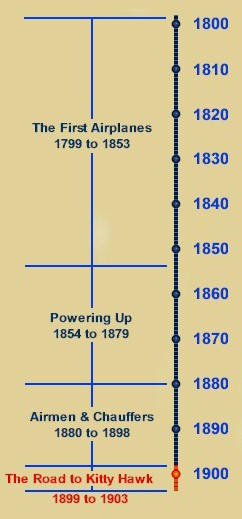
|
Time
|
Event
|
|
1899 |
Winter and Spring — The Wright
brothers consider methods to twist the wings of an aircraft or
change the angle of attack, simultaneously increasing the
lift on one side of the aircraft while decreasing the lift
on the other. All the methods they can imagine,
however, seem too heavy or too complex.
May 30 — Wilbur Wright writes the
Smithsonian asking for published materials on aeronautics. He is answered by
Richard
Rathbun, who sends four pamphlets and a list of other publications.
June — Wilbur Wright sells a
customer a
bicycle inner tube, then toys with the small rectangular box that it came in while
he talks to the customer.
Wilbur notices that when he squeezes together the opposing corners, the box
assumes a helicoidal twist. In his mind’s eye, he sees the top and the
bottom of the box as the wings of a biplane with the ends twisting in
opposite directions.
June through August —
Samuel Langley and
Charles Manly make
additional flights with Aerodromes Nos. 5 and 6.
July — The Wright brothers build a biplane
kite with a wingspan of 6 feet (183 centimeters) and control lines to twist
the wings in flight. When tested by Wilbur, it works
as planned. Unable to contain his enthusiasm, he pedals miles out into the
country side to find Orville, who is on a camping trip with friends. Immediately the
brothers begin planning a man-carrying version using data tables developed
by
Otto Lilienthal to achieve the necessary lift.
September 30 —
Percy Pilcher dies in a
crash of his Hawk, just as he is preparing to test a powered
airplane.
November 27 — Looking for a
place to test-fly a glider, Wilbur Wright writes the
United States Weather Bureau and inquires about locations with high winds. The weather
bureau sends him the Monthly Weather Review
for August and September, including wind
tables for 150 different locations in the United States.
|
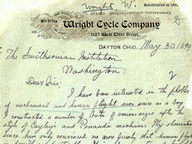
Wilbur's letter to the Smithsonian requesting information on
aeronautics.
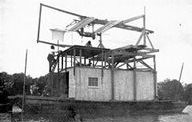
The floating workshop from which Langley launched his Aerodromes.
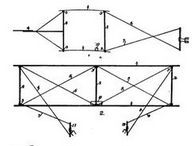
Wilbur's drawing of his 1899 kite.

Percy Pilcher with his Hawk
glider in 1898.
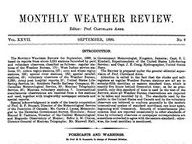
The Monthly Weather Review for
September, 1899.
|

To see an animated demo of Wilbur's inner tube
box experiment, click on the image.
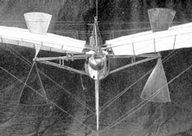
Langely Aerodrome No. 5.
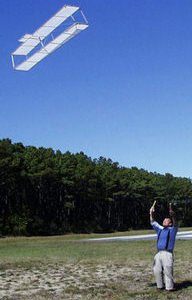
Flying a replica of the 1899 kite.
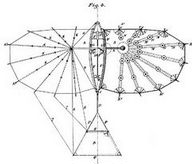
The patent drawing of Pilcher's powered plane. By
the time he built it, the design had evolved to a triplane with straight,
rectangular
wings. |
|
1900 |
Spring and Summer — The Wrights plan and build parts for their first
glider.
May 13 — Wilbur Wright writes
Octave
Chanute and asks for advice concerning where to test a glider.
Chanute suggest several places, among then the barrier islands on the
Eastern seaboard. Wilbur consults the wind tables in the Monthly Weather
Review and finds Kitty Hawk, North Carolina sixth on the list.
August 3 — Wilbur Wright
writes to the weather station at Kitty Hawk, asking for information on weather and lodging.
August 16 —
Joseph Dosher, the chief of the
Kitty Hawk weather station, responds to Wilbur’s letter. Dosher also refers
Wilbur’s letter to
William Tate, the county
commissioner and former postmaster. Tate also writes
Wilbur, providing more details about Kitty Hawk
September 13 — Wilbur Wright arrives in
Kitty Hawk, stays with the Tates, and begins to assemble a glider.
September 28 — Orville Wright arrives with
camping gear, food, and a mandolin. He also brings a camera, the first ever seen in Kitty
Hawk. The brother stay in a 12-foot by 22-foot tent, about a mile from the Tates. They
assemble a biplane glider with movable elevator — they have located the
elevator at the front of the aircraft. They begin to test the glider as a kite,
making at least on flight with Wilbur aboard. Wilbur will not let Orville
fly until he’s sure the glider is safe. Orville begins a
humorous correspondence with his sister Katharine, whom he is very close to.
October 10 — The Wrights experience
a setback when the wind picks up the glider and smashes it. But they rebuild the
aircraft and resume their tests.
October — The Wrights send 10-year-old Tom Tate,
William’s nephew up on the glider as they fly it like a kite. Later on,
just before they leave to go back home, Wilbur makes about a dozen free
flights.
October 23 — The Wrights break camp and
head for Dayton. The are puzzled by failure of glider to produce the lift
they had calculated, but they are encouraged
by success of the wing warping and elevator controls.
|
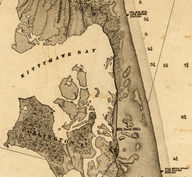
A nautical map of Kitty Hawk, NC from 1900.
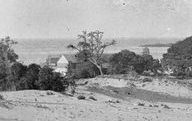
Kitty Hawk Bay in 1900.
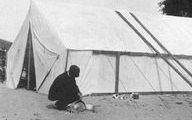
The Wright brothers' camp near Kitty Hawk in 1900.
Wilbur is "washing" a pan in the sand.
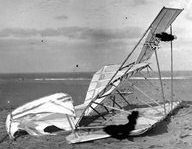
The 1900 Wright glider after the wind wrecked it.
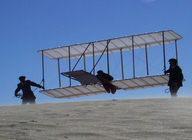
Before they left Kitty Hawk, the Wright brothers
made a
series of free flights with a pilot aboard. Above is a reenactment of
one of these flights. |
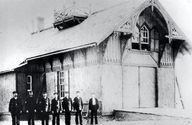
The US Coast Guard Lifesaving Station at Kitty Hawk,. NC doubled
as the US Dept. of Agriculture Weather Station.
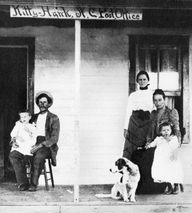
Bill Tate (left, seated), his wife, daughters (right,
seated)(, and a friend (right,standing)
on their porch in Kitty Hawk.
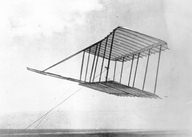
The Wright brothers flew their first glider mostly
as a kite.
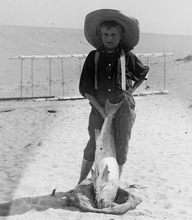
Tom Tate posed in front of the 1900
glider with a large Drum fish that he had caught.
|
|
1901 |
Wilbur Wright publishes a technical paper on
gliding in British and German journals.
Ferdinand Ferber, France, builds
and tests a crude copy of a Lilienthal glider, but it is
unsuccessful.
The Wrights plan another trip to
Kitty Hawk and begin to build their second glider. Because the first didn't
produce enough lift, this glider will have a much larger wing area and a
deeper camber.
Octave Chanute asks the Wrights to work with
Edward
Huffaker and
George Spratt (of Pennsylvania) to test
a glider in Kitty Hawk that Huffaker is building for Chanute.
June — The Wrights hire
Charlie
Taylor to run their bicycle shop in their absence.
July 10 — Wrights arrive at Kitty Hawk
and
establish camp at Kill Devil Hills four miles to south, then build a shed to serve as a hangar.
They are plagued by mosquitoes and Edward Huffaker. Orville writes to
Katharine that he can’t decide which is worse, the mosquitoes or Huffaker.
July 27 — The Wrights
test their glider with Huffaker and Spratt helping. It doesn’t fly as well as their first
glider, once again it does not produce the expected amount of lift. It also shows a pronounced tendency to
dive or climb. The Wrights begin to suspect that Otto Lilienthal's
lift tables are wrong. The diving/climbing problem, they deduce, is caused by
their wing design. The deep camber causes the center of pressure to
reverse itself quickly as the wing's angle of attack changes. This in turn
causes the nose of the glider to pitch up or down. The brothers truss the glider wings to take some of the
curve out of the ribs and reduce the camber.
August 4 — Octave Chanute arrives at the
Wright’s camp.
August 8 — The Wrights
test their
trussed 1901 glider and it performs reasonably well, although it isn't as responsive to
its controls as the 1900 Wright glider. Orville makes his first
flights.
August 9 — When Wilbur Wright attempts a
turn, the glider behaves oddly. The increased drag on the "high"
wing (the wing generating the most lift) causes the glider to yaw in the
opposite direction of the intended turn. The Wrights are perplexed.
Mid-August — Chanute, Huffaker,
and Spratt depart the Wright camp
August 20 — The Wrights, discouraged, break
camp. Wilbur comments to Orville that it could a thousand years before
manned flight is a reality.
Later, Wilbur remembers his dark mood, "We doubted that we would ever resume our
experiments...At this time, I made the prediction that men would sometime fly, but it
would not be in our lifetime."
September 18 — At Chanute’s request,
and sister Katharine's insistence, Wilbur
Wright delivers a paper to the Western Society of Engineers in Chicago, Illinois.
Wilbur suggests to the group that the Lilienthal data on lift and wing
shapes is wrong.
Fall and Winter — The Wrights build a wind tunnel
and conduct their
own research on wing surfaces, testing over 200 shapes. They find that
Otto Lilienthal was, in fact, correct in his measurements of lift and
drag. The lift problems that plague the Wrights are due to another important number used to design
airplanes. It is called Smeaton's Coefficient and it is essential to
calculating
the pressure of the wind on a wing. Jonathon Smeaton, the author of
the coefficient, had been wide of the mark when he proposed its value in
1758.
|
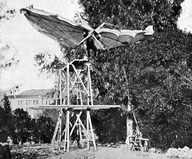
Ferdinand Ferber tests his Lilienthal-type glider.
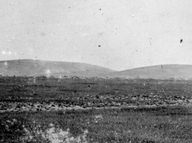
Kill Devil Hills, south of Kitty Hawk, NC.
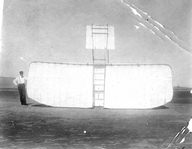
Orville shows the 1901 Wright glider. At the time,
this was the largest gliding machine anyone had ever
attempted to fly.

Dan Tate (left) and Edward Huffaker (right) launch Wilbur (center)
aboard the 1901 glider.
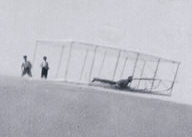
For safety, Wilbur attempted to follow the slopes of the dunes when
gliding, often flying only a few feet off the ground.
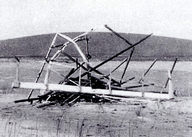
Huffaker built an experimental glider to Chanute's specs, but, substituted
cardboard tubes for wood in the airframe. The glider all but dissolved in the first
rain.
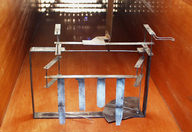
The Wright "lift balance" measured the lift produced
by a wing shape.
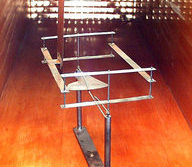
The "drift balance" measured the ratio of lift to
drag. |
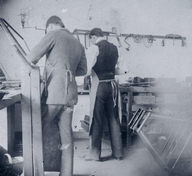
Charlie Taylor (left) and Orville Wright (center) at work in
the Wright Cycle Company.
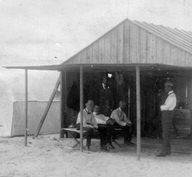
The Wright camp at Kill Devil Hills. Octave Chanute (left),
Edward Huffaker (left center) and Orville Wright (right
center) are seated, Wilbur Wright (right) is standing.
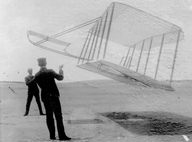
Wilbur and Orville fly their 1901 glider as a kite.
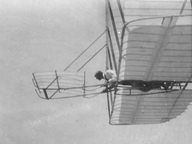
Wilbur flying the trussed 1901 glider.
The trussing enabled the Wrights to make some respectable
straight-ahead flights, but the glider did not behave well
in turns.
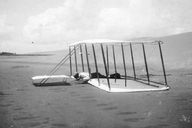
Wilbur and the 1901 glider after a hard landing.
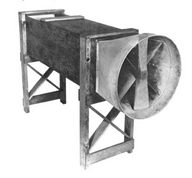
A replica of the Wright wind tunnel. The original was
discarded.
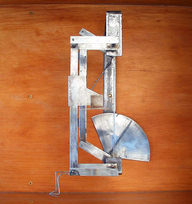
Both balances were designed to be read from the top, looking
down through the window in the top of the wind tunnel.
|
|
1902 |
The Wrights
plan their third glider, this time with a much greater scientific
understanding of aeronautics and wing design.
Ferdinand Ferber,
learns of
Octave Chanute's work from a
published lecture, contacts Chanute, and Chanute tells Ferber of
the Wright brothers.
Ferber begins to correspond with the
brothers and builds a copy of their 1901 glider as he understands it from
the photos Chanute has sent him. Although Ferber is aware
the Wright glider had roll control, he judges it useless and
does not include it in his own aircraft. His flight tests
are less than satisfactory.
August 28 — The Wrights arrive in Kitty
Hawk, repair their shed and build an extension.
September 8 — The Wrights begin to assemble
their new glider. It has a fixed tail that the
brothers hope will overcome the wing drag that caused the 1901 glider to yaw in
the opposite direction of the intended turn.
September 19 — The Wrights begin testing
the 1902 glider. Its performance and control response is much improved over
their previous gliders, but when making a slow turn the fixed tail
causes the turn to become tighter and tighter. The glider spins in on one
wing in a frightening maneuver the brothers dub "well-digging."
September 23 — Orville Wright crashes and
nearly destroys the 1902 glider, but the Wrights rebuild it.
September 29 — Wrights resume tests with
repaired glider.
September 30— George Spratt and Lorin
Wright arrive at camp for a visit.
October 2 — Orville Wright suggests
converting the fixed tail to a movable rudder to eliminate the well-digging problem. Wilbur agrees and they do so. They connect the
rudder control to the wing warping system.
October 5 — Octave Chanute and
Augustus
Herring arrive at the Wright camp, bringing with them another
glider, this one built by Charles H. Lamson. It has oscillating wings
that Herring and Chanute hope will make it stable in the air.
October 8 — The Wright's modified glider
work perfectly, with no tendency to spin or "well-dig." It outperforms the Lansom glider
by a wide margin.
October 17 — Augustus Herring leaves Kitty
Hawk and visits
Samuel Langley in Virginia, looking for work. He tells
Langley of the Wright’s success with their new machine.
October 19 — Samuel Langley cables the Wrights,
requesting information on their "special curved surfaces" and asking to come to
Kitty Hawk. The Wrights decline.
October 28 — The Wrights break camp,
already planning a powered aircraft.
Winter — The Wrights inquire at automobile
companies for a suitable gasoline engine for their aircraft, but cannot find one that
meets their needs. Charlie Taylor begins building an
aircraft engine for the Wrights.
December — Samuel Langley asks Octave
Chanute to help him get a foot in the door with the Wrights,
but
Chanute can’t get them to talk to Langley.
|
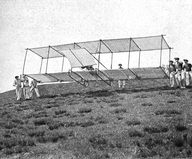
Ferber's 1902 glider was based on the Wrights' 1901
design.
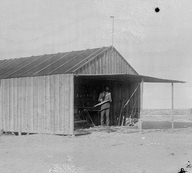
Upon returning to Kitty Hawk in 1902, the Wrights added to the length of their
wooden hangar to accommodate the longer wingspan of their new glider.
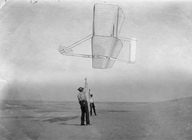
The Wrights kite their 1902 glider to measure its lift and drag. For the first
time, the performance of the machine agrees with their calculations.

The 1902 Wright flight crew from left to right: Octave Chanute, Orville
Wright, Wilbur Wright, George Spratt, Augustus Herring, and Dan Tate.
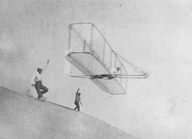
After some experimentation the Wrights convert the
fixed tail of their glider to a movable rudder. This, together with wing warping and the
elevator, makes the glider controllable in all three axes – roll, pitch, and yaw . For the first
time, their machine can turn safely in the air.
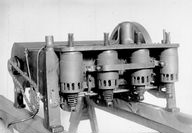
The first Wright airplane engine was designed for
simplicity so the Wright's mechanic. Charlie Taylor, could build it with
the limited metalworking equipment they had on hand. Nonetheless
it incorporated some innovations, among them one of the first aluminum
engine blocks.
|
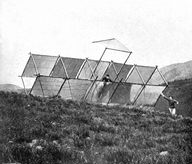
It's crude construction, however, led to
a poor performance.
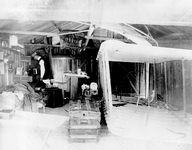
The interior of the Wright's camp building.
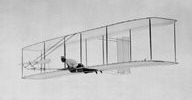
The 1902 Wright Glider initially had a fixed
tail that the Wrights had hoped would solve the turning problem. It
didn't.
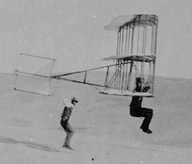
Chanute brought a glider with "oscillating" wings and
had Herring test-fly the machine. It did not perform well.
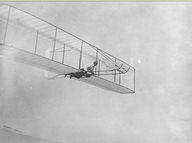
Wilbur soars out from the dune aboard the modified glider.
Note the discarded Lansom machine at the bottom left.
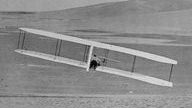
Orville recovers from a right turn. Note the right wing tips
are warped down and the rudder is angled to the left.
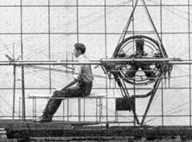
The cockpit of Langely's Aerodrome. By the end of 1902, the
project was over a year behind schedule and Langley was out
of funds.
|
|
1903 |
February —
Ferdinand Ferber,
France, publishes an account of his gliding experience
with a Wright-type glider in L'Aérophile.
Winter — The Wrights begin to design their
first aircraft
propellers. The calculations are complex and confusing, and there are many heated
arguments.
April — The Wrights complete their first set of
propellers.
April — Octave Chanute lectures the
Aéro-Club
de France on the gliding experiments of the Wright brothers.
They are astonished at the Wrights' accomplishments and the news galvanizes
a number of them into action. Chanute also gives the club the impression
that the Wrights are his "pupils."
April —
In the magazine La Locomotion,
Ernest Archdeacon,
France, proposes a "gliding competition" for French aviation
enthusiasts to encourage them to catch up to the Wright
brothers. Archdeacon later subscribes 3000 francs to be
used as prize money.
Summer —
Ferdinand Ferber,
who has continued to test and improve his
Wright-type glider, attaches a
6 hp motor and a primitive propeller to it. He attempts to fly
the aircraft tethered to a crane,
but
the flight tests are unsuccessful.
August —
Octave Chanute publishes the details of the Wright
brothers' 1902 glider in
L'Aérophile.
August 8 —
Samuel Langley successfully flies a quarter-scale
gasoline-powered model of his man-carrying Great
Aerodrome.
September 25 — The Wrights return to Kitty
Hawk.
September 28 — Wrights practice flying with
the 1902 glider and build a new hanger for the Flyer.
October 7 — Samuel Langley tests his
man-carrying Great Aerodrome on the Potomac, with Charles
Manly at the controls. The machine plunges into the river. Langley
claims that the airplane snagged on its launch mechanism, but analysis of
photos show that the wings are not strong enough to hold their shape. The
front wing deforms seconds after launch, angling the Aerodrome down.
October 23 — George Spratt visits the Wright’s
camp.
November 4 — When the Wrights test their
assembled Flyer for the first time, it damages both propeller shafts. George
Spratt takes the shafts back to Dayton with instructions for Charlie
Taylor to rebuild them.
November 5 — Octave Chanute visits the
Wright camp.
November 8 — Samuel Langley asks the War
Department for more money to rebuild and test his Aerodrome again. He gets it.
November 20 — Wrights receive the new
propeller shafts, but find the drive sprockets come loose on the shafts when
the Wrights "swing the props" to start the engine..
November 21 — The Wrights elect to use
bicycle tire cement to glue the sprockets to the shafts. The cement works.
November 28 — After the Wrights make
several tests, one of the new propeller shafts crack. Orville takes it back to Dayton
himself to remake it.
December 8 — Samuel Langley tests his
Great Aerodrome
again. And again it fails. Charles Manly is almost drowned in the crash.
December 11 — Orville Wright returns to
Kitty Hawk from Dayton with new shafts made of solid spring steel.
December 14 — The Wrights try to fly their
machine with Wilbur at the controls. But he misjudges the effect of the
elevator, the machine shoots
up 15 feet, stalls, and plows into the sand 105 feet from the point of takeoff. Neither
Wilbur or Orville consider this a true flight since the airplane was never
under Wilbur's control.
December 17 — At 10:35 am, Orville Wright makes the first powered flight in a fully controllable aircraft capable of
sustaining itself in the air. The flight lasts just 12 seconds and stretches only
120 feet (37 meters). In the next few hours, Wilbur and Orville make four flights,
the longest 59 seconds and 852 feet (260 meters). After the fourth flight, a gust of wind rolls the aircraft over and
smashes it. Wrights send a telegram to their father, Bishop Milton Wright,
informing him of their success. Katharine cables Octave Chanute
telling him of her brothers' first powered flights. December 27
— Octave Chanute invites Wilbur Wright
to speak about his powered flights to the American
Association for the Advancement of Science.
December 28 — Wilbur
Wright declines Octave Chanute's invitation,
saying, "We are giving no pictures nor descriptions of
machine or methods at present."
|
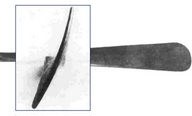
The Wrights were the first to realize that
propellers were wings that spun in a circle. Consequently, their props
were cambered (curved) like wings.
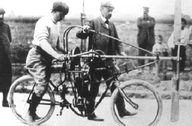
Ernest Archdeacon sits astride his "Aeromotorcyclette," a
propeller-powered motorcycle.
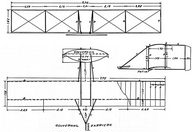
Chanute published these drawings of the 1902 Wright Glider, but in
accordance with the Wrights' wishes, he did not elaborate on the control
system.
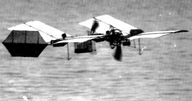
To test the design of his
Great Aerodrome, Langley flew this quarter-size
model. It was the first successful flight of a
gasoline-powered aircraft.
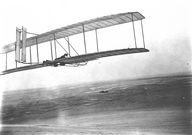
While the Wright brothers were constructing the
powered Flyer, they made practice
glides with the 1902 glider. They modified the rudder so it would
behave more like the Flyer.
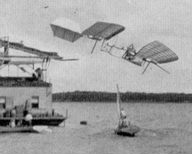
Langley's Great Aerodrome
launches for the first time. The machine slid into the
Potomac River "like a handful of wet cement" according to one
newspaper account.
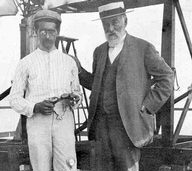
Samuel Langley (right) and Charles Manly (left), the pilot of the
Great Aerodrome. Note the
compass that Manly has sewn into his pants.
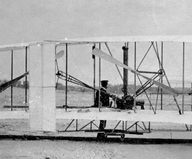
Orville inspects the reassembled Wright Flyer.
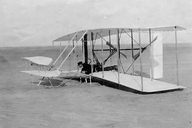
After the 14 December flight attempt, the front skids supporting
the elevator cracked on impact. They were easily repaired.
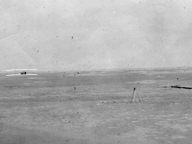
The fourth and last flight of 17 December covered 852 feet (260 meters).
The Wrights considered this the only true flight of the day because the
Flyer remained aloft long enough to prove that it was capable of
controlled and sustained powered flight. |
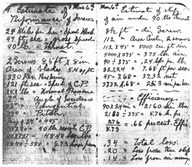
Some of the many calculations the Wright brothers made while
designing and testing their propellers.
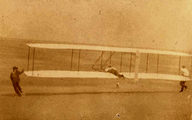
One of several photos taken by Octave Chanute as he observed
the Wright flying experiments in 1902.
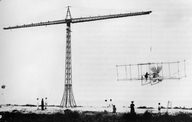
Ferber tested a motorized version of his glider while it was
attached to a counterbalanced crane to see whether the
propulsion system could produce enough lift for flight and
whether the controls were effective. It lacked both lift and
control.
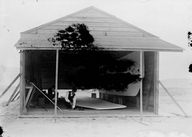
The Wright brothers building their Flyer at their camp at
the base of Kill Devil Hills.
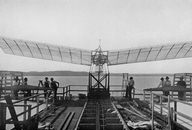
Workers assemble the Great Aerodrome on its launching track
atop a specially-built floating workshop and hangar.
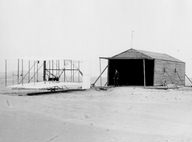
The completed 1903 Wright Flyer in front of its hangar. The
Wrights had to remove the elevator (front) and the rudder
(back) to stow the Flyer.
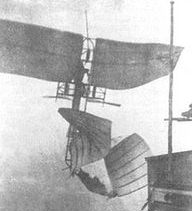
As soon as the Great
Aerodrome left the catapult on 8 December 1903, the
rear wings folded. The tail of the aircraft dropped and it
slid backwards into the Potomac River.
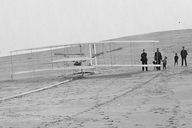
The Wright Flyer on its launching track on
14 December. Because the winds were lighter than they would
have liked, the Wright brothers set up the launching rail on
the slope of a dune.
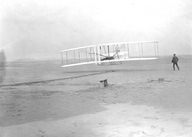
The Wright Flyer takes off from level ground for the first
time on 17 December 1903.
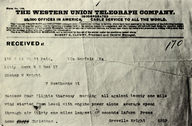
The telegram that Orville and Wilbur sent to their
father Milton announcing their success.
|
|
|
|
|